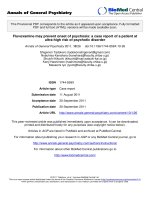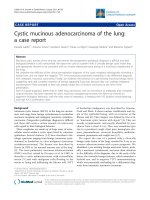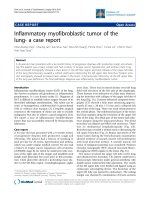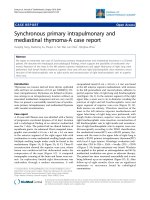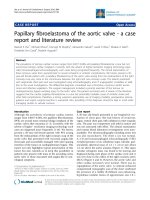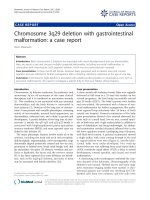Báo cáo y học: "Carbamazepine overdose after exposure to simethicone: a case report" pps
Bạn đang xem bản rút gọn của tài liệu. Xem và tải ngay bản đầy đủ của tài liệu tại đây (196.74 KB, 3 trang )
BioMed Central
Page 1 of 3
(page number not for citation purposes)
Journal of Medical Case Reports
Open Access
Case report
Carbamazepine overdose after exposure to simethicone: a case
report
Ozlem Guneysel*, Ozge Onur, Arzu Denizbasi and Murat Saritemur
Address: Marmara University, School of Medicine, Department of Emergency Medicine, Istanbul, Turkey
Email: Ozlem Guneysel* - ; Ozge Onur - ; Arzu Denizbasi - ;
Murat Saritemur -
* Corresponding author
Abstract
Introduction: Carbamazepine is an anticonvulsant drug and is also used as a treatment for
patients with manic-depressive illness, post-herpetic neuralgia or phantom limb pain. The drug itself
has many drug interactions. Simethicone is an antifoaming agent and is reported to be an inert
material with no known drug interaction with carbamazepine.
Case presentation: We present a case of a patient who was routinely using carbamazepine 400
mg three times per day and levetiracetam 500 mg twice daily, and experienced carbamazepine
overdose after exposure to simethicone. After cessation of simethicone therapy normal drug levels
of carbamazepine were obtained again with the standard dose of the drug. The mechanism of
interaction is unknown but the risk of overdose should be considered when prescribing
simethicone to a patient who is using carbamazepine.
Conclusion: Simethicone and carbamazepine, when taken together, may be a cause of
carbamazepine toxicity. The risk of carbamazepine overdose should be considered when
prescribing simethicone to a patient who is using carbamazepine.
Introduction
Carbamazepine (CBZ) is an anticonvulsant drug which
received approval for use as an anti-epileptic agent in the
United States in 1974. It is also used as a treatment for
patients with manic-depressive illness, post-herpetic neu-
ralgia or phantom limb pain. Therapeutic plasma concen-
tration is 4 to 12 mg/l. It is approximately 75% to 80%
protein-bound. CBZ is oxidized by hepatic microsomal
enzymes to produce its active metabolite, CBZ 10, 11-
epoxide. In terms of drug interactions, CBZ induces the
metabolism of other anticonvulsant drugs. Inhibitors of
hepatic microsomal enzymes such as erythromycin, clari-
thromycin and cimetidine increase CBZ levels [1]. Cyto-
chrome P450 3A4 (CYP3A4) inhibitors inhibit CBZ
metabolism and can thus increase plasma levels; CYP3A4
inducers can increase the rate of its metabolism.
Simethicone is an antifoaming agent that acts by altering
the surface tension of mucus-entrapped gas bubbles in the
digestive tract, allowing them to coalesce and disperse [2].
It is not absorbed, and is excreted unchanged in the feces
[3]. There is no known interaction of this drug with CBZ.
We present the case of a patient in whom simethicone is
the probable cause of CBZ toxicity. After cessation of
simethicone therapy normal drug levels of CBZ were
obtained again with standard dose of the drug.
Published: 24 July 2008
Journal of Medical Case Reports 2008, 2:242 doi:10.1186/1752-1947-2-242
Received: 12 November 2007
Accepted: 24 July 2008
This article is available from: />© 2008 Guneysel et al; licensee BioMed Central Ltd.
This is an Open Access article distributed under the terms of the Creative Commons Attribution License ( />),
which permits unrestricted use, distribution, and reproduction in any medium, provided the original work is properly cited.
Journal of Medical Case Reports 2008, 2:242 />Page 2 of 3
(page number not for citation purposes)
Case presentation
A 45-year-old man with a medical history of epilepsy pre-
sented to the emergency room with complaints of vertigo,
gait disturbance, dizziness, slurred speech and diplopia.
He had been using CBZ (Karazepin
®
) 400 mg three times
per day for 4 years and levetiracetam (Keppra
®
) 500 mg
twice daily for 1 year. No other toxin, alcohol, herbal
products or drugs were reported except for a history of 2
days simethicone (Metsil
®
) usage for abdominal disten-
tion. He had a blood pressure of 115/70 mmHg, a pulse
rate of 88 beats per minute and a respiratory rate of 18
breaths per minute. The patient had a normal mental sta-
tus and was able to give a reliable history. There were no
signs of dehydration. He reported no history of vomiting
or diarrhea. He denied trauma, extra drug dosage or sui-
cidal attempt. In his neurological examination, the patho-
logical findings were bilateral nystagmus, dysarthria,
diplopia and ataxic walking. He had a serum CBZ level
reported as 10.5 μg/ml 2 days earlier (blood sampled 10
to 11 hours after the last dose of CBZ; normal reference
range 4 to 11 μg/ml), confirmed in the neurology outpa-
tient clinic.
The initial laboratory findings were as follows: hemat-
ocrit, 41.5; prothrombin time, 12.3 seconds (reference
range 11 to 13 seconds); international normalized ratio,
1.02; creatinine, 0.97 mg/dl (reference range 0.5 to 1.10
mg/dl); glucose, 102 mg/dl (reference range 70 to 110
mg/dl); serum alanine aminotransferase, 16 U/L (refer-
ence range 10 to 37 U/l); aspartate aminotransferase, 17
U/l (reference range 10 to 40 U/l); alkaline phosphatase,
238 U/l (reference range 0 to 270 U/l); γ-glutamyltrans-
ferase, 46 U/l (reference range 7 to 49 U/l); total bilirubin,
0.54 mg/dl (reference range 0.2 to 1.0 mg/dl); and CBZ
serum level, 34.2 μg/ml (blood taken 8 to 9 hours after
the last dose of CBZ).
Cranial computed tomography scan was normal. Con-
firming the simethicone levels would have been helpful in
confirming the patient's report, but this test was not avail-
able.
The patient was taken to the neurology in-patient unit
with a diagnosis of CBZ intoxication. CBZ was withdrawn.
Treatment for intoxication comprised intravenous hydra-
tion and cardiac monitoring. After 36 hours his serum
CBZ level had normalized (17.6 μg/ml at 24 hours; 11.4
μg/ml at 36 hours) and neurological exam was intact. In a
follow-up visit the patient was warned about simethicone
use, and there have been no further problems in the fol-
lowing 6 months.
Discussion
CBZ is one of the most commonly prescribed drugs for the
prevention of partial seizures as well as for treatment of
generalized tonic-clonic seizures and trigeminal neuralgia
[4]. CBZ interacts with a number of drugs other than anti-
convulsants and there are a number of mechanisms
involved. The absorption of oral CBZ is slow, erratic and
unpredictable. Peak plasma concentrations generally
occur 4 to 8 hours after ingestion, but may require up to
26 hours to peak. It is rapidly distributed into the body
and has about 75% to 78% protein binding. CBZ is
metabolized in the liver by the cytochrome P450 system
and undergoes almost complete biotransformation to sev-
eral metabolites. The most important interactions affect-
ing the characteristics of CBZ are those resulting in the
induction of its metabolism. Clinically, a variety of drug
interactions between CBZ and co-administered drugs
have been reported. The actions of most drugs that affect
CYP3A4 by inhibition or induction manifest as drug inter-
actions with CBZ [5,6]. However, there has been no dem-
onstration of simethicone and CBZ interaction until now.
Simethicone has been used as an adjunct in the treatment
of various clinical conditions in which gas retention may
be a problem, including dyspepsia, infant colic, peptic
ulcer and irritable colon. It also appears to be helpful as
an adjunct to various procedures such as colonoscopy and
bowel radiography [7]. It is a mixture of liquid dimethyl-
polysiloxanes which have antifoaming activity. It acts in
the stomach and intestines by altering the surface tension
of gas and mucus bubbles, enabling them to coalesce. It is
reported as physiologically inert, and no toxic effects are
reported on ingestion [8].
As it is widely available, CBZ is a drug commonly involved
in accidental and intentional overdoses. The American
Association of Poison Control Centers reported a total
number of 18,201 CBZ overdoses from 1999 to 2001,
leading to 18 deaths [9]. Acute CBZ toxicity presents with
cardiac, respiratory and neurological effects. Neurological
signs include loss of consciousness, seizures, ataxia, chore-
oathetosis, myoclonus, motor restlessness, mydriasis and
nystagmus [10]. Most of these signs were positive in our
patient.
We have presented a case of CBZ toxicity due to simulta-
neous intake of simethicone. The Naranjo adverse drug
reaction probability scale was used as an objective meas-
ure of causality; a score of 7 was found [11]. Based on a
score of 7 on the Naranjo adverse drug reaction probabil-
ity scale, simethicone was the probable cause of CBZ tox-
icity in this patient. Both drugs are in wide use, but to date
there have been no studies examining the effects of sime-
thicone on the pharmacokinetics of CBZ. As simethicone
is an inert material, we could not explain the mechanism
of action. This interaction may be caused by extrahepatic
enzymatic processes. There are some reports regarding
absorption processes and CBZ therapeutic levels. It was
Publish with BioMed Central and every
scientist can read your work free of charge
"BioMed Central will be the most significant development for
disseminating the results of biomedical research in our lifetime."
Sir Paul Nurse, Cancer Research UK
Your research papers will be:
available free of charge to the entire biomedical community
peer reviewed and published immediately upon acceptance
cited in PubMed and archived on PubMed Central
yours — you keep the copyright
Submit your manuscript here:
/>BioMedcentral
Journal of Medical Case Reports 2008, 2:242 />Page 3 of 3
(page number not for citation purposes)
confirmed that simultaneous oral administration of TJ-9
(Sho-saiko-to extract powder) with CBZ to rats decreased
gastrointestinal absorption of CBZ, without affecting the
metabolism of CBZ [12]. In another study it was shown
that concomitant administration of Coca-Cola (an acidic
beverage) enhanced the rate and extent of absorption of
CBZ [13]. An absorption effect may therefore be responsi-
ble for CBZ toxicity in a patient taking simethicone and
CBZ together.
In a patient with CBZ toxicity, possible causes such as
multiple drug ingestions, beverages, herbal products, drug
overdoses and liver function abnormalities should be
considered. Our patient had been taking CBZ for 4 years;
during this period no adverse events were reported until
simethicone usage. This patient's follow-up was excellent.
Conclusion
Simethicone and CBZ, when taken together, may be a
cause of CBZ toxicity. The risk of CBZ overdose should be
considered when prescribing simethicone to a patient
who is using CBZ.
Abbreviations
CBZ: carbamazepine; CYP3A4: Cytochrome P450 3A4.
Competing interests
The authors declare that they have no competing interests.
Authors' contributions
OG and OO were involved in the literature search, writing
and conception of the report. AD and MS conceived of
and gave final approval to the report. All authors read and
approved the final manuscript.
Consent
Written informed consent was obtained from the patient
for publication of this case report and accompanying
images. A copy of the written consent is available for
review by the Editor-in-Chief of this journal.
References
1. Kapoor N, Hamilton RJ: Toxicity, carbamazepine. [http://
www.emedicine.com/emerg/topic77.htm].
2. Voepel-Lewis TD, Malviya S, Burke C, D'Agostino R, Hadden SM,
Siewert M, Tait AR: Evaluation of simethicone for the treat-
ment of postoperative abdominal discomfort in infants. J Clin
Anesth 1998, 10:91-94.
3. Bilim, Pharmaceuticals: Simethicone. Pertinent data on File.
Istanbul: Bilim Pharmaceuticals.
4. Kim KA, Oh SO, Park PW: Effect of probenecid on the pharma-
cokinetics of carbamazepine in healthy subjects. Eur J Clin
Pharmacol 2005, 61:275-280.
5. Spina E, Pisani F, Perucca E: Clinically significant pharmacoki-
netic drug interactions with carbamazepine. An update. Clin
Pharmacokinet 1996, 31:198-214.
6. Rambeck B, Specht U, Wolf P: Pharmacokinetic interactions of
the new antiepileptic drugs. Clin Pharmacokinet 1996, 31:309-324.
7. McNally PR, Maydonovitch CL, Wong RK: The effect of sime-
thicone on colonic visibility after night-prior colonic lavage.
A double-blind randomized study. J Clin Gastroenterol 1989,
11:650-652.
8. World Health Organization: FAO/WHO Expert Committee Food Addi-
tives Technical Report Series No. 648 Geneva: WHO; 1980.
9. Askenazi DJ, Goldstein SL, Chang IF: Management of a severe
carbamazepine overdose using albumin-enhanced continu-
ous venovenous hemodialysis. Pediatrics 2004, 113:406-409.
10. Stremski ES, Brady WB, Prasad K, Hennes HA: Pediatric car-
bamazepine intoxication. Ann Emerg Med 1995, 25:624-630.
11. Naranjo CA, Busto U, Sellers EM, Sandor P, Ruiz I, Roberts EA,
Janecek E, Domecq C, Greenblatt DJ: A method for estimating
the probability of adverse drug reactions. Clin Pharmacol Ther
1981, 30:239-245.
12. Ohnishi N, Okada K, Yoshioka M, Kuroda K, Nagasawa K, Takara K,
Yokoyama T: Studies on interactions between traditional
herbal and western medicines v. effects of sho-saiko-to (xiao-
cai-hu-tang) on the pharmacokinetics of carbamazepine in
rats. Biol Pharm Bull 2002, 25:1461-1466.
13. Malhotra S, Dixit RK, Garg SK: Effect of an acidic beverage
(Coca-Cola) on the pharmacokinetics of carbamazepine in
healthy volunteers. Methods Find Exp Clin Pharmacol 2002,
24:31-33.
